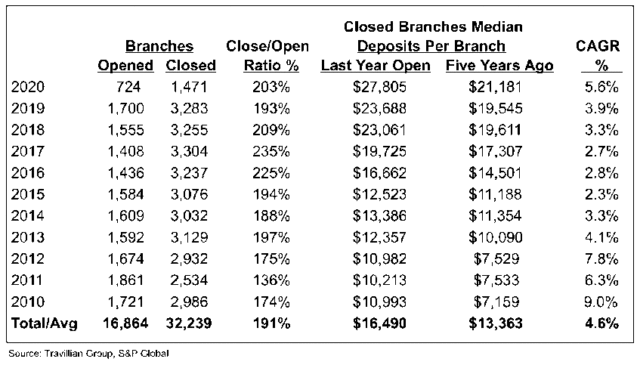Introduction. For many years, bank delivery models have been transforming due to massive digital adoption, which was accelerated in 2020 with no sign of looking back. A recent survey (Novantas) indicated less than half of consumers say they will return to branches once Covid-19 restrictions are lifted.
In addition to the forcefully-changed dynamic with delivery channels, the bank industry is faced with intense pressure to lower costs in a tougher revenue environment to create operating leverage (to the extent that is possible). Add on the current provisioning needs and uncertainty around the economy, and it is no wonder banks as a group are still trading around tangible book value and down more than 30% YTD.
The need to adapt. Cutting costs to reach profitability goals in a lower margin environment is required. Banks need to create platforms that are cost-effective at underwriting loans, creating the best customer experience, and providing products and services with less real estate, overhead, and compliance risk. In the past, the concern was that reducing branches might damage the core franchise or send the wrong signal to customers. But it now appears to be only a matter of time before we see a wave of closures and even while trimming expenses, investment to compete needs to increase. An unintended byproduct of training customers to accept more efficient delivery channels actually opens them up to competition from larger, lower-cost online providers. Another recent survey (Bank Director) indicated only 37% of banks have partnered with new technology providers since COVID-19 hit.
Branch closures have been twice as fast as openings. There have been slightly over 175,000 branches in the US (we looked at branches established since the late 1800s). Bank branches have shrunk by 6% since 2010; we were surprised by the number of branches opened in the past decade – nearly 17,000. Nonetheless, banks have closed nearly twice as many branches as opened during the same time frame. As evidenced by the corresponding table, the amount of deposits in branches being closed has increased in the past decade. The number of closures was accelerating between 2011-2017. It used to be that $20M a branch was viewed as break-even territory; we think the amount has increased in the past few years to $25M with annual operating costs in the $600-800k range.
Before reducing branch count, plan on how to remain engaged with businesses. A study by an economist at the University of California, Berkeley, found when merging banks close a branch, the number of small-business loans made in the area fall by 13% for more than eight years afterward. There is a tight relationship between business lending and branch locations given its relational nature.
Branches need to be evaluated in terms of profit, growth, and risk. There are a lot of different ways to look at the branch network for potential savings. Consider the following when formulating potential closures.
1. Look at Profitability. Put all the branches on a list and rank them by profitability. Consider the bottom 30%-35% as a starting list of names to consider closing. Exclude facilities opened in the past five years given the investment; hopefully, they are more modern, tech-savvier layouts.
2. Look at Growth. From the list of least (or un-profitable) branches, look at the growth dynamics of deposits and the growth of the area. Weight each factor 50% and consider approximately half of the list as possible candidates for the following year.
3. Nearby Facilities. Take the remaining list and see if there is a branch within 5-10 miles. A closer range could be selected but starting with this range should keep the possibilities for considering a closure an option, while still retaining the ability to service customers on an appointment basis.
4. Consider CRA and Other Issues. The first three steps should give a bank 10-15% of its branch structure to consider closing. The last step is thinking about regulatory scrutiny and any other strategies that are being considered – growth in certain markets, where management would like to take the franchise from a geography perspective long-term.
The bottom line is most companies could have 10% of their employees not present on a given day and the work would still get done (because this group is not carrying much weight). The same is likely true for banks. Thinking about a ~10% reduction in a year feels appropriate given the present changes occurring to the industry.
Lastly, think about this question on each facility – is the bank better off financially without this branch?
Final Thought. Today in banking, strong leadership translates into the following: having an effective strategy to engage current and future customers, delivering products and services in a more cost effective manner, reacting effectively to sudden and significant change… All while keeping the workforce engaged and focused. Successful companies develop new business opportunities by making greater investments than peers in new businesses opportunities and marketing. Focus and invest in core capabilities that cement customer relationships, because this will matter the most over the long haul. Cut costs surgically, but also invest for the future.
The Travillian Group’s Banks and Credit Unions practice provides Search and Talent Advisory (TTG|Align) services to depository institutions across the country. Established in 1998, the firm has built a unique platform that touches every corner of the industry.
Our search and advisory professionals focus on building long-term, trust-based relationships with Boards, Executives and HR professionals. They assist our clients in the hiring of high quality, hard to find talent and provide full-life cycle consulting in such areas as succession management, leadership development, employee engagement, recruitment strategies and compensation.













